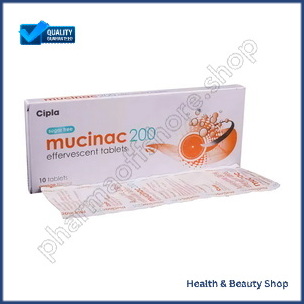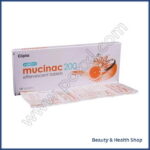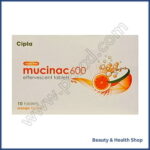ADDICTION
ALCOHOL DEPENDENCE
QUIT SMOKING
ALLERGY
ANTI FUNGAL
FUNGAL INFECTION
FUNGAL NAIL INFECTIONS
ANTI-REJECTION DRUGS
ANTI WORM
ANTIBIOTIC
BACTERIAL INFECTIONS
ARTHRITIS
GOUT
OSTEOARTHRITIS
RHEUMATOID ARTHRITIS
BLOOD
LOW PLATELET COUNT
THROMBOPHLEBITIS
VARICOSE VEINS
COLON
ANAL FISSURE
PILES
ULCERATIVE COLITIS
DIABETES CARE
DIABETES INSIPIDUS
DIABETES TYPE
DIABETIC FOOT ULCERS
GLUCOSE MONITOR
EYES/EAR CARE
DRY EYES
EYE CARE
EYE EXAMINATION
EYE INFECTION
EYE LASHES
EYE PAIN
GLAUCOMA
OCULAR HYPERTENSION
UVEITIS
FEVER CARE
MALARIA
RHEUMATIC FEVER
TYPHOID FEVER
GASTROINTESTINAL
ACIDITY
CONSTIPATION
CROHN'S DISEASE
DIARRHOEA
GALLBLADDER STONES
INTESTINAL ULCERS
IRRITABLE BOWEL SYNDROME
MOTION SICKNESS
NAUSEA
Mucinac (Acetylcysteine)
Mucinac 200 mg (Acetylcysteine)
Mucinac 600 mg (Acetylcysteine)
| Active Ingredient (Generic Name): | Acetylcysteine |
|---|---|
| Indication: | Mucolytic (loosen mucus in the airways) |
| Manufacturer | Cipla Limited |
| Packaging: | 10 Effervescent tablets in one strip |
From: $44.00
Acetylcysteine, known as Mucinac, thins mucus in the airways for conditions like bronchitis, pneumonia, and cystic fibrosis. Take the prescribed dose orally, measuring carefully. Stay hydrated to aid mucus loosening. It can counter acetaminophen overdose and may treat idiopathic pulmonary fibrosis. Notify your healthcare provider about allergies and existing conditions such as ulcers. Guarantee proper storage and disposal. Seek advice from a professional for personalized guidance. Learn about potential drug interactions and brand names like Mucomyst. By understanding dosage, precautions, and more uses, you can maximize benefits.
Start by understanding the basic function of Mucinac (Acetylcysteine) in treating respiratory conditions. Mucinac, a medication commonly prescribed for respiratory issues, works by thinning and loosening mucus in the airways. This helps individuals with conditions like bronchitis, pneumonia, or cystic fibrosis to cough up the mucus more easily, thereby improving breathing and reducing the risk of infections.
When you take Mucinac orally, it gets broken down in the body to produce a substance called cysteine. Cysteine plays an essential role in breaking down the disulfide bonds that hold mucus proteins together. By disrupting these bonds, Mucinac makes the mucus less sticky and more liquid-like, allowing it to be expelled from the lungs more effectively.
For individuals with respiratory conditions characterized by thick, sticky mucus that is difficult to clear, Mucinac can be a valuable treatment option. It helps to alleviate congestion, reduce coughing fits, and improve overall respiratory function.
Why is this medication prescribed?
Mucinac (Acetylcysteine) is prescribed to help individuals with respiratory conditions by thinning and loosening mucus in the airways. This medication is commonly used to treat conditions such as bronchitis, pneumonia, cystic fibrosis, and chronic obstructive pulmonary disease (COPD). By thinning the mucus, Mucinac makes it easier for individuals to cough up the excess mucus, which can help improve breathing and reduce the risk of lung infections.
In respiratory conditions, mucus can become thick and sticky, making it difficult to clear from the airways. Acetylcysteine, the active ingredient in Mucinac, works by breaking down the disulfide bonds in the mucus, making it less viscous and easier to expel. This medication is available in various forms, including oral solutions, effervescent tablets, and inhalation solutions, allowing for different administration methods depending on the individual’s condition and needs. It is vital to follow the prescribed dosage and administration instructions provided by your healthcare provider to guarantee the medication’s effectiveness and safety.
How should this medicine be used?
When using Mucinac (Acetylcysteine), it is important to adhere to the prescribed dosage and administration instructions provided by your healthcare provider for best effectiveness and safety. Typically, this medication is taken by mouth as a solution or tablet. It is vital to follow the exact dosing schedule recommended by your doctor. If you are unsure about any aspect of taking Mucinac, do not hesitate to ask your healthcare provider or pharmacist for clarification.
To take Mucinac as a solution, you may need to mix the prescribed amount with a liquid to make it easier to swallow. Be sure that you measure the dose accurately using a special measuring device, not a regular spoon, to avoid dosage errors. If you are using the effervescent tablets, dissolve them in a glass of water as directed. Remember to drink plenty of fluids while using Mucinac to help loosen mucus in the lungs. If you miss a dose, take it as soon as you remember, but do not double the dose to catch up. If you have any concerns or experience side effects while taking Mucinac, contact your healthcare provider promptly.
Other uses for this medicine
Exploring additional applications of this medication can provide insights into its versatility and potential benefits beyond its primary use. Acetylcysteine, commonly known as Mucinac, is primarily used to help break down mucus in conditions such as chronic bronchitis, pneumonia, and cystic fibrosis. However, this medication has shown promise in other medical scenarios. One notable application is its use as an antidote for acetaminophen (paracetamol) overdose, where it helps prevent liver damage by replenishing glutathione levels. Additionally, acetylcysteine has been studied for its potential in treating conditions like idiopathic pulmonary fibrosis, where its antioxidant properties may help reduce lung tissue scarring. Furthermore, this medication is being explored for its role in preventing contrast-induced nephropathy in patients undergoing certain medical imaging procedures. While further research is needed to solidify these alternative uses, the versatility of acetylcysteine underscores its potential in various medical contexts beyond its conventional uses.
What special precautions should I follow?
Before taking Mucinac (Acetylcysteine), be sure to check with your healthcare provider if you have any existing health conditions. It’s important to inform them about any allergies, medications, or past reactions to similar drugs. Following these precautions can help guarantee the safe and effective use of this medication.
Check Existing Health Conditions
To guarantee your safety while using Mucinac (Acetylcysteine), what specific health conditions should you be cautious about? When contemplating using Mucinac, it is vital to be mindful of your existing health conditions. Here are some important health conditions to ponder:
- History of Peptic Ulcers: Increases the risk of gastrointestinal bleeding.
- Asthma: Can trigger bronchospasms in some individuals.
- Liver Disease: May require dosage adjustments due to potential effects on liver function.
- Renal Impairment: Monitoring kidney function is essential to prevent any adverse effects.
Being aware of these conditions and discussing them with your healthcare provider will help ensure a safe and effective use of Mucinac.
What special dietary instructions should I follow?
Consider incorporating foods rich in antioxidants, such as fruits and vegetables, into your diet while taking Mucinac (Acetylcysteine) to support your overall health. Antioxidants help protect your cells from damage caused by free radicals, promoting better health and well-being. Including a variety of colorful fruits like berries, oranges, and apples, as well as vegetables like spinach, kale, and bell peppers, can provide you with a range of antioxidants essential for your body.
Additionally, it’s important to maintain a balanced diet rich in nutrients while on Mucinac. Make sure to include sources of lean protein, whole grains, and healthy fats in your meals to support your overall health and well-being. Drinking an adequate amount of water is also vital to help with the thinning of mucus and to keep your body hydrated.
What should I do if I forget a dose?
If you miss a dose of Mucinac (Acetylcysteine), take it as soon as you recollect. However, if it is nearly time for your next dose, skip the missed dose and continue with your regular dosing schedule. Avoid taking an extra dose to compensate for the one you missed, as this can heighten the risk of side effects without offering any additional advantages. It is essential to maintain a consistent dosing schedule to guarantee the medication works effectively in your body.
If you frequently forget doses, consider setting reminders on your phone, using a pill organizer, or integrating taking your medication into your daily routine to help you recollect. If you have difficulty remembering to take your medication, talk to your healthcare provider who may be able to offer additional tips or strategies to help you stay on track with your treatment plan. Consistency in taking your medication as prescribed is vital for achieving the best results and managing your health condition effectively.
What side effects can this medication cause?
When taking Mucinac (Acetylcysteine), it’s important to be watchful for any persistent symptoms. Some side effects can be severe, so if you notice any concerning symptoms, contact your doctor promptly. It’s vital to monitor your well-being closely and seek medical advice if you experience any worrisome reactions.
Monitor for Persistent Symptoms
Be vigilant for any potential side effects that Mucinac (Acetylcysteine) may cause as you monitor for persistent symptoms. It is important to stay aware of how your body reacts to this medication. Here are some side effects to watch out for:
- Nausea: Feeling sick to your stomach can be a common side effect.
- Vomiting: Some individuals may experience episodes of vomiting.
- Rash: Keep an eye out for any unexpected skin rashes or irritation.
- Headache: Headaches might occur as a result of taking Mucinac.
Monitoring these symptoms closely can help you and your healthcare provider manage any potential side effects effectively.
Some side effects can be serious. If you experience any of the following symptoms, call your doctor immediately:
As you monitor for persistent symptoms and potential side effects of Mucinac (Acetylcysteine), it is essential to be aware of serious side effects that may require immediate medical attention. If you experience any of the following symptoms, call your doctor immediately:
- Severe allergic reactions such as rash, itching, swelling, severe dizziness, or trouble breathing.
- Chest tightness or chest pain.
- Persistent cough or coughing up blood.
- Changes in vision or eye pain.
Being vigilant about these potential side effects can help you address any serious issues promptly and safeguard your well-being. If you notice any of these symptoms, seek medical help without delay to receive appropriate care and guidance. Your health is a priority, and timely action is critical in managing any adverse reactions to the medication.
What should I know about the storage and disposal of this medication?
To guarantee the effectiveness of Mucinac (Acetylcysteine), store the medication in a cool, dry place away from direct sunlight and moisture. Keeping it in these conditions helps maintain its stability and potency. Make sure that the medication is tightly sealed in its original container to prevent contamination or exposure to air. Avoid storing Mucinac in the bathroom or kitchen, as humidity and temperature changes in these areas can affect its quality.
When it comes to disposal, follow proper guidelines to ensure the safe discarding of Mucinac. Do not flush this medication down the toilet unless instructed to do so. Check with your pharmacist or local waste disposal facility for specific instructions on how to dispose of Mucinac properly. It is important to adhere to these guidelines to prevent environmental contamination and potential harm to others. If you have any questions or concerns about the storage or disposal of Mucinac, consult your healthcare provider or pharmacist for further guidance.
In case of an emergency/overdose
In an emergency or in the event of an overdose with Mucinac (Acetylcysteine), immediately contact poison control or seek medical assistance. If you suspect an overdose, whether accidentally or intentionally, it is important to act promptly. Symptoms of an overdose may include nausea, vomiting, diarrhea, and abdominal pain. In severe cases, overdosing on Acetylcysteine can lead to more serious symptoms such as blurred vision, confusion, and difficulty breathing. It is essential to provide healthcare providers with detailed information about the amount of medication ingested and the timing of the overdose.
When seeking medical help, be prepared to share the prescription details, any underlying health conditions, and other medications being taken concurrently. Emergency responders or healthcare professionals may administer treatments to counteract the effects of the overdose and provide necessary supportive care. Do not hesitate to call for help, as timely intervention in cases of overdose is critical for ensuring the best possible outcome.
What other information should I know?
Make sure you are well-informed about potential drug interactions and side effects before using Mucinac (Acetylcysteine). It is essential to inform your healthcare provider about all the medications, supplements, and herbal products you are currently taking before starting Mucinac. Acetylcysteine can interact with certain medications, such as nitroglycerin, which could lead to decreased effectiveness. Additionally, if you have a history of asthma, you should exercise caution when using Mucinac, as it may exacerbate respiratory symptoms in some individuals. Inform your healthcare provider if you are pregnant or planning to become pregnant, as the effects of Mucinac on pregnancy are not entirely clear.
While using Mucinac, be aware of potential side effects such as nausea, vomiting, and diarrhea. It is vital to follow the recommended dosage and not exceed the prescribed amount to minimize the risk of adverse effects. Contact your healthcare provider if you experience severe or persistent side effects while taking Mucinac. Remember to store Mucinac at room temperature, away from moisture and heat, and keep it out of reach of children.
Brand names
When looking for Mucinac (Acetylcysteine), you may come across different brand names that contain the same active ingredient. This medication is available under various brand names, each offering the benefits of acetylcysteine for respiratory conditions. Below is a table listing some common brand names for acetylcysteine:
| Brand Name | Active Ingredient |
|---|---|
| Mucinac | Acetylcysteine |
| Fluimucil | Acetylcysteine |
| Mucomyst | Acetylcysteine |
| Acetadote | Acetylcysteine |
These brand names all contain acetylcysteine as the active ingredient, providing mucolytic properties to help with conditions like bronchitis, pneumonia, and cystic fibrosis. It is essential to follow your healthcare provider’s guidance on which brand to use and the appropriate dosage for your specific condition. Familiarize yourself with these brand names to recognize the medication when prescribed under a different name, ensuring you receive the intended treatment effectively.
Purchase Options for Mucinac
Consider exploring different pharmacies and online retailers to find various purchase options for Mucinac (Acetylcysteine). When looking for Mucinac, it is advisable to compare prices and availability from multiple sources to guarantee you are getting the best deal. Local pharmacies, such as CVS or Walgreens, may carry Mucinac in stock, allowing for convenient same-day pickup. Additionally, major retailers like Walmart or Target often stock this medication both in-store and online, providing flexibility in how you obtain it.
For those preferring the convenience of online shopping, websites like Amazon or online pharmacies can also be viable options for purchasing Mucinac. When ordering online, be sure to factor in shipping costs and delivery times to determine the most efficient way to receive your medication. Some online retailers may offer discounts or bulk purchasing options, which could result in cost savings over time. By exploring a variety of purchase options, you can find the most convenient and cost-effective way to obtain Mucinac for your needs.
To summarise
Exploring different purchase options for Mucinac can help you find the most convenient and cost-effective way to obtain this medication. Various avenues exist for acquiring Mucinac, including local pharmacies, online retailers, and through healthcare providers. Local pharmacies offer the advantage of immediate access, allowing you to pick up your prescription promptly. Online retailers provide convenience and the possibility of discounted prices, although delivery times may vary. Consulting with your healthcare provider can offer insights into potential cost-saving programs, such as manufacturer coupons or patient assistance programs. Additionally, discussing your prescription with your doctor can guarantee you receive the appropriate dosage and understand how to take Mucinac correctly. By considering these factors and comparing prices, you can make an informed decision on where to purchase Mucinac. Remember, always follow your healthcare provider’s instructions and guidance when obtaining and taking any medication like Mucinac.








